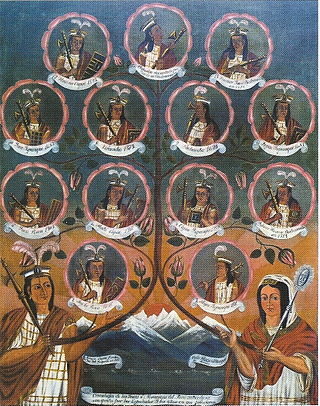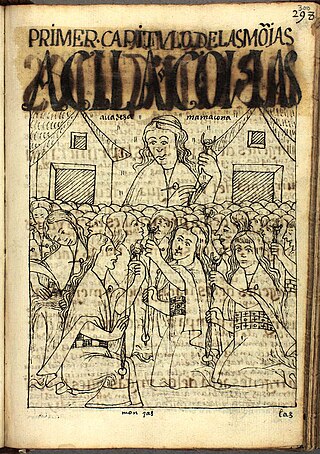
The Inca Empire, officially known as the Realm of the Four Parts, was the largest empire in pre-Columbian America. The administrative, political, and military center of the empire was in the city of Cusco. The Inca civilization rose from the Peruvian highlands sometime in the early 13th century. The Spanish began the conquest of the Inca Empire in 1532, and by 1572 the last Inca state was fully conquered.

Chicha is a fermented (alcoholic) or non-fermented beverage of Latin America, emerging from the Andes and Amazonia regions. In both the pre- and post-Spanish conquest periods, corn beer made from a variety of maize landraces has been the most common form of chicha. However, chicha is also made from a variety of other cultigens and wild plants, including, among others, quinoa, kañiwa, peanut, manioc, palm fruit, rice, potato, oca, and chañar. There are many regional variations of chicha. In the Inca Empire, chicha had ceremonial and ritual uses.

Pachacuti Inca Yupanqui, also called Pachacútec, was the ninth Sapa Inca of the Chiefdom of Cusco, which he transformed into the Inca Empire. Most archaeologists now believe that the famous Inca site of Machu Picchu was built as an estate for Pachacuti.
The ayllu, a family clan, is the traditional form of a community in the Andes, especially among Quechuas and Aymaras. They are an indigenous local government model across the Andes region of South America, particularly in Bolivia and Peru.

Communal work is a gathering for mutually accomplishing a task or for communal fundraising. Communal work provided manual labour to others, especially for major projects such as barn raising, "bees" of various kinds, log rolling, and subbotniks. Different words have been used to describe such gatherings.
Mit'a was mandatory service in the society of the Inca Empire. Its close relative, the regionally mandatory Minka is still in use in Quechua communities today and known as faena in Spanish.

Quechua people, Quichua people or Kichwa people may refer to any of the Indigenous peoples of South America who speak the Quechua languages, which originated among the Indigenous people of Peru. Although most Quechua speakers are native to Peru, there are some significant populations in Ecuador, Bolivia, Chile, Colombia, and Argentina.
The Repartimiento was a colonial labor system imposed upon the indigenous population of Spanish America and the Philippines. In concept, it was similar to other tribute-labor systems, such as the mit'a of the Inca Empire or the corvée of the Ancien Régime de France: Through the pueblos de indios, the Amerindians were drafted work for cycles of weeks, months, or years, on farms, in mines, in workshops (obrajes), and public projects.

The Incas were most notable for establishing the Inca Empire which was centered in modern-day South America in Peru and Chile. It was about 4,000 kilometres (2,500 mi) from the northern to southern tip. The Inca Empire lasted from 1438 to 1533. It was the largest Empire in America throughout the Pre-Columbian era. The Inca state was known as the Kingdom of Cuzco before 1438. Over the course of the Inca Empire, the Inca used conquest and peaceful assimilation to incorporate the territory of modern-day Peru, followed by a large portion of western South America, into their empire, centered on the Andean mountain range. However, shortly after the Inca Civil War, the last Sapa Inca (emperor) of the Inca Empire was captured and killed on the orders of the conquistador Francisco Pizarro, marking the beginning of Spanish rule. The remnants of the empire retreated to the remote jungles of Vilcabamba and established the small Neo-Inca State, which was conquered by the Spanish in 1572.
The Inca society was the society of the Inca civilization in Peru. The Inca Empire, which lasted from 1438 to 1533 A.D., represented the height of this civilization. The Inca state was known as the Kingdom of Cusco before 1438. Over the course of the empire, the rulers used conquest and peaceful assimilation to incorporate a large portion of western South America, centered on the Andes mountain ranges. The empire proved relatively short-lived however: by 1533, Atahualpa, the last Sapa Inca (emperor) of the Inca Empire, was killed on the orders of the conquistador Francisco Pizarro, marking the beginning of Spanish rule. The last Inca stronghold, the Neo-Inca State in Vilcabamba, was conquered by the Spanish in 1572.
A kuraka, or curaca, was an official of the Andean civilizations, unified by the Inca Empire in 1438, who held the role of magistrate, on several hierarchical levels, from the Sapa Inca at the head of the Empire to local family units.

Aclla, also called Chosen Women, Virgins of the Sun, and Wives of the Inca, were sequestered women in the Inca Empire. They were virgins, chosen at about age 10. They performed several services. They were given in marriage to men who had distinguished themselves in service to the empire; they produced luxury items, weaving fine cloth, preparing ritual food, and brewing the chicha (beer) drunk at religious festivals; and some, the most "perfect," were selected as human sacrifices for religious rites. Others lived out their lives in a monastic environment.

Inca agriculture was the culmination of thousands of years of farming and herding in the high-elevation Andes mountains of South America, the coastal deserts, and the rainforests of the Amazon basin. These three radically different environments were all part of the Inca Empire and required different technologies for agriculture. Inca agriculture was also characterized by the variety of crops grown, the lack of a market system and money, and the unique mechanisms by which the Incas organized their society. Andean civilization was "pristine"—one of six civilizations worldwide which were indigenous and not derivative from other civilizations. Most Andean crops and domestic animals were likewise pristine—not known to other civilizations. Potatoes and quinoa were among the many unique crops; Camelids and guinea pigs were the unique domesticated animals.
Mitma was a policy of forced resettlement employed by the Incas. It involved the forceful migration of groups of extended families or ethnic groups from their home territory to lands recently conquered by the Incas. The objective was to transfer both loyalty to the state and a cultural baggage of Inca culture such as language, technology, economic and other resources into areas that were in transition.

Chinchaypujio is one of nine districts of the Anta Province in Peru and about 2 hours outside of Cusco. Its capital, Chinchaypujio, hosts a weekly market (Mercado Ferial de Chinchaypujio) as well as the regional government. The district is home to 9 communities: Chinchaypujio, Ocra, Paucarccoto, Parcotica, Waccahualla, Huancancalla, Sumaru, Pantipata and Huamumayo. In its southernmost part, the Apurímac River crosses the district; a major trade road connecting the Cuzco Department with the Department of Apurímac crosses through the entire district from north to south.
Yanakuna were originally individuals in the Inca Empire who left the ayllu system and worked full-time at a variety of tasks for the Inca, the quya, or the religious establishment. A few members of this serving class enjoyed high social status and were appointed officials by the Sapa Inca. They could own property and sometimes had their own farms, before and after the conquest. The Spanish continued the yanakuna tradition developing it further as yanakuna entered Spanish service as Indian auxiliaries or encomienda Indians.
The Tawantinsuyu or Inca Empire was a centralized bureaucracy. It drew upon the administrative forms and practices of previous Andean civilizations such as the Wari Empire and Tiwanaku, and had in common certain practices with its contemporary rivals, notably the Chimor. These institutions and practices were understood, articulated, and elaborated through Andean cosmology and thought. Following the Spanish conquest of the Inca Empire, certain aspects of these institutions and practices were continued.
The vertical archipelago is a term coined by sociologist and anthropologist John Victor Murra under the influence of economist Karl Polanyi to describe the native Andean agricultural economic model of accessing and distributing resources. While some cultures developed market economies, the predominant models were systems of barter and shared labor. These reached their greatest development under the Inca Empire. Scholars have identified four distinct ecozones, at different elevations.

Ocra is a Quechuan Campesino community within the Chinchaypujio District in Peru and about 1.5 hours outside of Cusco; its central village is located at 3,670 m (12,040 ft) altitude.

The economy of the Inca Empire, which lasted from 1438 to 1532, was based on local traditions of "solidarity" and "mutualism", transported to an imperial scale, and established an economic structure that allowed for substantial agricultural production as well as the exchange of products between communities. It was based on the institution of reciprocity, considered the socioeconomic and political system of the Pre-Columbian Andes.











